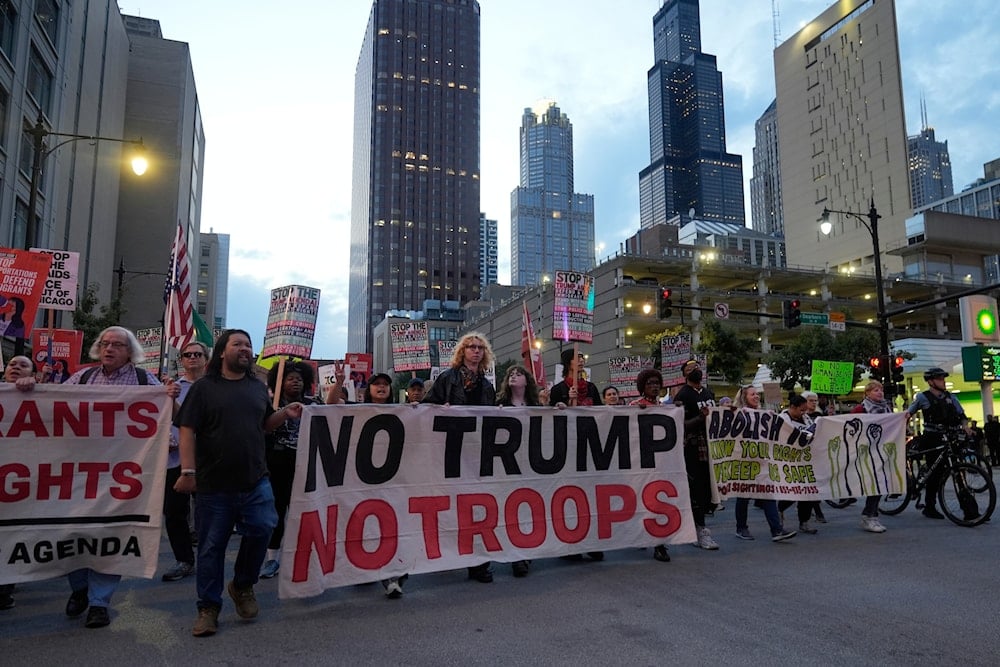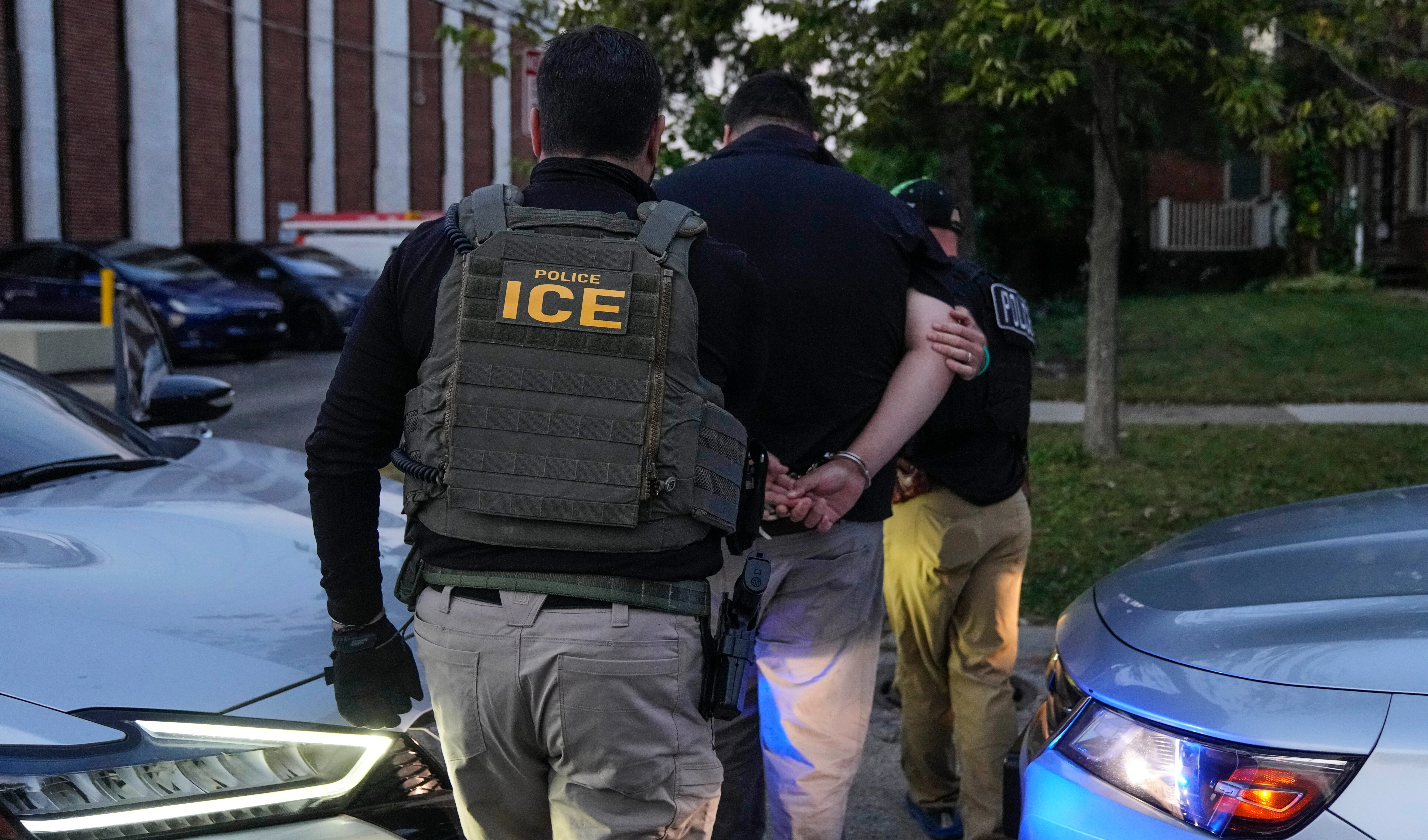HRW slams federal agents use of excessive force in Illinois protests
Human Rights Watch accuses federal agents of using excessive force on peaceful protesters, medics, and journalists during ICE raids in Illinois
-

Demonstrators march at a protest opposing "Operation Midway Blitz" and the presence of ICE, Tuesday, Sept. 9, 2025, in Chicago (AP)
Since mid-September 2025, federal law enforcement agents have used excessive force against peaceful protesters, legal observers, volunteer street medics, and journalists during demonstrations outside a US Immigration and Customs Enforcement (ICE) detention facility in suburban Chicago, according to a statement released by Human Rights Watch on Thursday.
Following the initiation of ICE’s “Operation Midway Blitz” on September 8 and the subsequent increase in immigration raids and seizures throughout the Chicago area, the protests at the Broadview, Illinois, facility escalated.
Video and witness accounts show DHS agents, sometimes alongside other police, repeatedly used excessive force against non-threatening protesters, as well as clearly marked journalists, legal observers, and street medics.
According to Human Rights Watch, law enforcement detained dozens of protesters alongside at least one journalist and one street medic, with this violent response coming on the heels of the excessive force used against protesters of immigration raids in Los Angeles this past June.
Campaign of intimidation
Belkis Wille, associate crisis and conflict director at Human Rights Watch, stated, "This is not crowd control, but a campaign of intimidation," explaining that federal agents are employing chemical irritants and projectiles against peaceful protesters, volunteer street medics, and journalists in broad daylight to send an unambiguous message that dissent will be punished.
Human Rights Watch, after interviewing 18 people present during the Broadview protests, including 7 protesters, 4 journalists, a volunteer street medic, 2 immigration rights advocates, and a religious leader, and analyzing 17 videos from the protests that were posted to social media or provided to researchers, compiled its findings.
According to witness testimony and video evidence, DHS agents used tear gas and fired projectiles directly into groups of protesters who did not appear to pose any risk to them, often without any warning and from positions that included the detention facility roof.
Raven Geary, a journalist shot in the face with a pepper spray projectile on September 26 after attending numerous protests at the facility, stated that while she has been to many protests over the years, "I have never seen anything like this response in my life," adding, "There is no rhyme or reason to the violence agents are resorting to."
Ashley Vaughan, a protester who uses a cane, told HRW that agents shot them with pepper balls on September 12, causing them to momentarily "black out", while on September 19, agents shot Reverend David Black in the head with a pepper ball as he was peacefully praying near the facility in an incident captured on video.
According to the National Lawyers Guild of Chicago, at least 10 legal observers have been injured during the protests. The Guild also reported that from September 19 to October 14, at least 78 people were detained by federal, state, and local officers.
Furthermore, two interviewees and a colleague of a third person stated that they were held for 6 to 12 hours and were denied access to their attorneys despite numerous requests.
Law enforcement forces challenge the law
A class action lawsuit has been filed in federal court in Illinois against President Donald Trump and senior officials from DHS, ICE, and other agencies. The plaintiffs, a coalition of media groups, journalists, and protesters, allege the government used excessive force, suppressed free speech and religious expression, and made unlawful arrests.
In response to the lawsuit, a US district court issued a temporary restraining order on October 9, limiting the protest policing tactics that federal agents can use in northern Illinois; however, this order was quickly tested.
Photographs from October 14 appear to show federal agents deploying chemical irritants against protesters on Chicago's south side. This incident is reported as a potential violation of the court's restraining order, suggesting that the confrontational tactics cited in the original lawsuit may be continuing despite judicial intervention.
Federal agents have repeatedly used excessive and unnecessary force during the protests, often attacking protestors and others without provocation in actions that implicate both US Constitutional civil rights protections and specific DHS policies governing when and how law enforcement may use force to disperse protests.
Agents conceal their identities
Human Rights Watch further reported that, according to those interviewed and the media content reviewed, almost all DHS agents at the protests had their faces covered, which obscured their identities. Additionally, many were not wearing badges or uniforms to clearly identify their agency positions, thereby undermining accountability and basic protections from arbitrary detention or abuse.
Based on its analysis of witness accounts and video footage, Human Rights Watch identified several DHS agencies and units present at the protests in various configurations, including ICE, through its Enforcement and Removal Operations and Homeland Security Investigations divisions, Customs and Border Protection, which deployed its Border Patrol Tactical Unit, and the Federal Protective Service.
Personnel from the Bureau of Alcohol, Tobacco, Firearms, and Explosives, the Federal Bureau of Investigation, the Drug Enforcement Administration, and the Federal Bureau of Prisons were also frequently present, alongside various local and state law enforcement officials.
Projectiles targeted peaceful individuals
Human Rights Watch found that federal agents repeatedly used chemical irritants and projectiles against peaceful, non-threatening individuals, including pepper balls, tear gas, and foam rounds, directly at people, violating international standards on proportional force.
Specific incidents involved unprovoked attacks. Ashley Vaughan was shot with pepper balls while livestreaming, causing them to lose consciousness, while Reverend David Black was hit in the head while praying, then sprayed with mace at close range. Video evidence verified by HRW supports these accounts.
On September 26, agents targeted non-threatening people, including a person playing a guitar and an older woman reading notes on a fence. One medic reported treating severe injuries from close-range impacts, including a forehead laceration.
The systematic practice of firing projectiles and tear gas directly at individuals from the facility's roof, rather than for dispersal, demonstrates a pattern of excessive force that risks serious injury or death.
Violence against journalists, observers, and medics
Federal agents systematically targeted journalists, despite clear press identification. Reporter Raven Geary was shot in the face with a pepper projectile, causing severe bruising, while other journalists, like Paul Goyette and Charles Thrush, were also directly fired upon while visibly wearing press credentials.
The targeting extended to legal observers and medics. Agents shot observers in the face and neck while they wore distinctive green hats. Street medics were fired upon while treating injured protesters, and their medical tents were chemically attacked and dismantled.
Even isolated journalists faced deliberate attacks. A CBS reporter was shot with pepper balls while driving past the empty protest site, with videos verified by HRW showing agents firing tear gas directly at journalists standing peacefully across an intersection.
This pattern demonstrates a coordinated effort to suppress documentation and medical aid, according to Human Rights Watch, which emphasized that the repeated, deliberate attacks on clearly identified non-combatants violated basic safety and press freedom protocols.

 7 Min Read
7 Min Read








